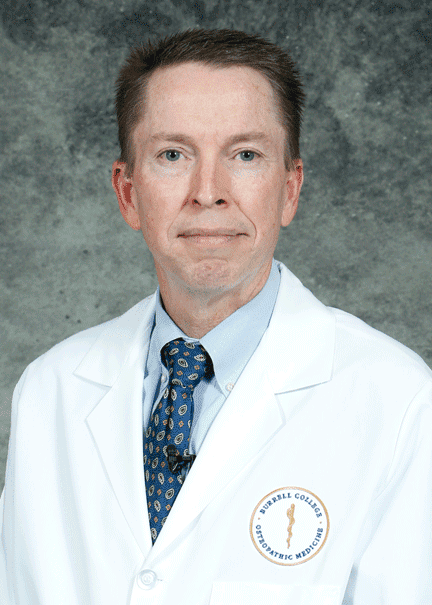Trump's doctor may be the first osteopathic physician to serve as president's top healer
LAS CRUCES, N.M. – As President Donald Trump spent last weekend at the Walter Reed National Military Medical Center in Washington, D.C., being treated for COVID-19 disease, his physician entered the spotlight as he presented daily updates about the president's condition.
Some of the attention on Navy Cmdr. Sean Conley arose from contradictory information he provided over the weekend and when he acknowledged Sunday that despite his cheerful presentation on the president's health Saturday he had not disclosed the president had received supplemental oxygen and was taking a steroid medication generally prescribed in severe cases of coronavirus infection.
Explaining the lack of disclosure, Conley told reporters he had been "trying to reflect the upbeat attitude that the team, the president, over his course of illness, has had."
The man overseeing and explaining the president's treatment is also reportedly the first physician to a sitting president to hold a doctorate of osteopathy rather than being an MD, or Doctor of Medicine.
How sick is the president? Trump latest commander-in-chief to downplay medical troubles
From COVID-19 to voting: Trump is nation's single largest spreader of disinformation, studies say
Like MDs, osteopathic doctors are state-licensed physicians who can prescribe medication and treat patients through the United States. They receive similar training but with a different viewpoint on the body's health and healing capacities.
To review the distinctions between a DO and an MD, the Las Cruces Sun-News, part of the USA TODAY Network, spoke with physician Bill Pieratt, dean and chief academic officer at the Burrell College of Osteopathic Medicine in Las Cruces, N.M.
This conversation has been edited for brevity and clarity.
What is the distinction between a DO and an MD?

Bill Pieratt: It really is a different philosophy of healing. Osteopathic medicine focuses on wellness and the body's ability to kind of self-regulate, self-heal and achieve that equilibrium. It does that through osteopathic manipulation techniques (OMT) to identify any sort of dysfunction and restore function, alignment, balance and so forth.
Those techniques may be different types of musculoskeletal manipulations or adjustments. There are also muscular stretches and counter-stretches. There are soft-tissue techniques that augment lymphatic flow.
We use the same techniques as allopathic medicine and then add these osteopathic principles and techniques.
On the allopathic side, there has been a more contemporary approach to come alongside the osteopathic philosophy of taking a more holistic approach and facilitating wellness, not simply limiting practice to the treatment of disease.
What is 'allopathic' medicine?
Pieratt: Allopathic medicine is just the term used for what is considered the more traditional Western medical training (leading to an MD degree).
Is there a tension between these approaches?
Pieratt: If you go back probably to the early 20th century, even into the mid-20th century, there was probably more tension. The osteopathic training and profession was probably less well-known and less well understood.
Today, an undergraduate student who wants to become a physician is going to take the same foundational science courses and the same Medical College Admission Test. In fact, many students apply to both MD and DO-granting medical schools. Both of those schools are four years in duration and when you graduate you have a medical degree that then permits you to enter a residency training program, which is the next step in becoming a practicing, licensed physician.
The residency programs accept both MD and DO graduates. Upon completion of a residency, a physician then is "board eligible" to sit for a board certification exam.
There are DO physicians in every sub-specialty of medicine and surgery, just as there are traditional MD physicians. DOs aren't really limited to practicing a specific discipline of medicine. They are licensed and trained in the same disciplines that MD physicians are.
We follow the same licensing the same board certification and maintain the same license requirements, the rights and privileges and responsibilities, and that's all governed at the state medical board level.
The additional curriculum that applies to the osteopathic principles and techniques accounts for about 200 extra hours within the medical curriculum.
What is osteopathic manipulation?
Pieratt: It's a hand-on approach. There are techniques intended to both diagnose and treat some of the imbalances and dysfunctions that may impede the body's physiology and its ability to regulate and heal.
Some of it may be musculoskeletal, some of it may be related to physiology and the balance of not just the musculoskeletal system but the lymphatic system, the immune system and so forth.

Have there been changes of practice in osteopathy and/or allopathic practice that have changed the relationship between them?
Pieratt: It used to be the emphasis in osteopathic medicine was more on primary care than specialties. Historically, you had more DOs going into things like family medicine and internal medicine and pediatrics, but today you have DOs practicing in all specialties and sub-specialties of medicine. You have DOs who are neurosurgeons and dermatologists and heart surgeons. There is not an area of medicine where a DO does not or cannot practice.
Where things have changed the most have been in the residency trainings. There used to be separate osteopathic residency programs, and now you have MD graduates and DO graduates training alongside each other in common programs that accept both.
In doing that, I think it improves the working relationship between the two and it sort of demystifies the differences.
MD and DO physicians train alongside each other in residency, they practice alongside each other, and they often participate in the care of a given patient together. It's like any other working relationship where you assess someone for their competency, not based on what you think you understand about their background or their training.
Follow Algernon D'Ammassa on Twitter: @AlgernonWrites
This article originally appeared on Las Cruces Sun-News: Trump's doctor Sean Conley is a DO: What is osteopathic medicine?


